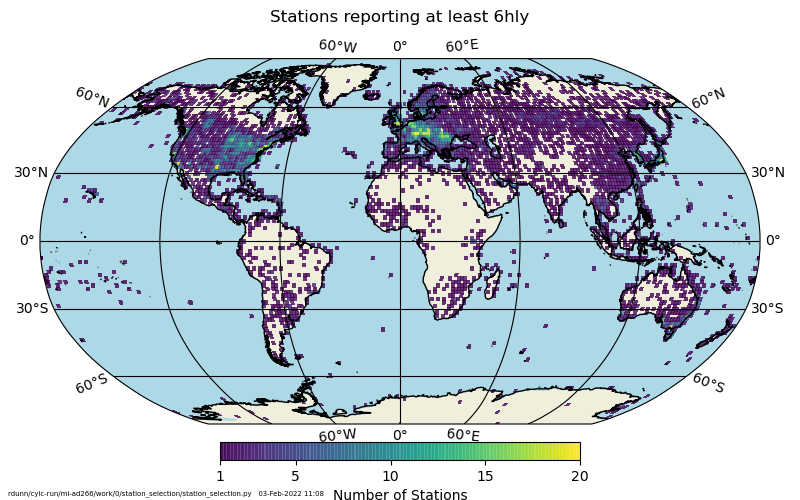HadISD - global sub-daily station dataset -
version 3.3.0.2022f
Note for version 3.2.0.202109p and later:
The temperatures recorded in the recent western Canada & US
heatwave in late June 2021 were sufficiently extreme and beyond
climatology that a number of these have been flagged by our
automated QC tests. We have updated some of the QC tests as
detailed in our blog posts
(1,
2,
3,
4).
Therefore the minor version number has incremented by one (from
3.1.2 to 3.2.0). If you spot anything untoward as a result of
these changes please do let us know. (07-Oct-2021)
Note for version 3.3.0.202201p and
later:
An issue has been discovered in how calm winds are encoded in the
ISD after 2013. We describe the cause and impacts in Dunn et al, 2022, ERC. From this version onwards we have
adjusted our routines to recover these calm periods. We have
also updated the record values used by the World Record Check,
and hence there has been an extra increment in the version
number (08-Feb-2022, updated 08-Jul-2022)
Note for version 3.3.0.2022f and
later:
We have updated the calculation for the wet bulb temperature to reflect that now used for HadISDH. The original formula from Jenson et al (1990)
was giving strange values at low RH at very high temperatures. The routines have been updated to use the formula from Stull (2011). For further
details see forthcoming post on the HadISDH blog.
(10-Jan-2023)
HadISD is a global sub-daily dataset based on
the ISD dataset
from NOAA's NCEI. As well as station
selection criteria, a suite of quality control tests has been run on
the major climatological variables. The data span 1/1/1931 to end
December 2022 and each station is available individually. The current
version of HadISD is 3.3.0.2022f. For previous versions
please contact the dataset maintainers.
This is a new version of HadISD, version
3.3.0.2022f. This version is the final one for
2022 and hence has the final character "f". The station lists
have been updated over v3.2.1.2021f, but will remain the same
until February 2023 and v3.3.1.202301p. Further details are given in
the blog and also
a Hadley
Centre Technical Note. For full details see the Changelog.
A station listing with IDs and location information
is here
(also with names).
Brief description of the data
Individual stations within the ISD were composited when
it was appropriate to do so. Then stations were selected on the basis of
their length of record and reporting frequency. There are 9555
stations in HadISD.3.3.0.2022f, and these
were passed through a suite of automated quality control tests
designed to remove bad data while keeping the extremes. None of the
ISD flags were used. The QC tests focussed on the temperature,
dewpoint temperature and sea-level pressure variables, although some
were applied to the wind speed and direction and cloud data. The
data files also contain other variables which were pulled through from
the raw ISD record, but have had no QC applied. Note: These data have not
yet been homogenised and so trend fitting should be undertaken with
caution. Results from the homogeneity assessment can be
found here.
Keep in touch
Follow us on twitter: @metofficeHadOBS for updates, news and announcements.
For more detailed information, follow our HadISD blog. Here we describe bug fixes, routine updates and other exploratory analysis.
|

Figure shows the distribution of HadISD stations on
a 1x1degree grid. These are the subset from the ISD which
report at least every 6 hours and have a long enough record. It was created when refreshing
the station list for v3.3.0.202201p.
|
References
When using the dataset in a paper, the following are
the correct citations to use. Please also state the
version number used and date of download
Dunn, R. J. H., (2019), HadISD version 3: monthly updates,
Hadley Centre Technical Note
Dunn, R. J. H., et al. (2016), Expanding HadISD: quality-controlled, sub-daily station data from 1931,
Geoscientific
Instrumentation, Methods and Data Systems, 5, 473-491
Dunn, R. J. H., et
al. (2014), Pairwise homogeneity assessment of HadISD,
Climate
of the Past, 10, 1501-1522
Dunn, R. J. H., et
al. (2012), HadISD: A Quality Controlled global synoptic
report database for selected variables at long-term stations
from 1973-2011, Climate of the Past, 8, 1649-1679
Smith, A., et al. (2011): The Integrated Surface
Database: Recent Developments and
Partnerships. Bulletin
of the American Meteorological Society, 92, 704-708
|
Commercial and media enquiries
You can access the Met Office Customer Centre, any time
of the day or night by phone, fax or e-mail. Trained staff will help
you find the information or products that are right for you.
Contact
the Met Office Customer Centre
|
|
Quality Control Code
The python code used for the station selection and quality control can be
found on github.
We do not intend to provide in-depth
support for this code. We emphasise that the choices we have made in
the selection and QC one of a number of other
equally reasonable choices, and encourage other interested parties to
develop their own QC and filtering procedures to allow the structural
uncertainties of this sub-daily dataset to be investigated.
Homogeneity Assessment
We have assessed the homogeneity of four of the observed
meteorological variables present in HadISD: temperature, dew point
temperature, sea-level pressure and wind speed. This has been
performed on monthly averages of the sub-daily data, and is fully
described in Dunn et
al, 2014, Climate of the Past, 10, 1501-1522. The homogeneity
assessment results for v3.3.0.2022f are available for
download here.
Online Material
A number of summary and diagnostic outputs from the quality control
code as well as station lists for a number of selection criteria are
available here. Also available is
the information from the homogeneity assessment of v3.3.0.2022f.
We have adapted our versioning system
from CRUTEM4,
and so the dataset numbering is of the form HadISD.X.Y.Z.1234i, and
is outlined in more detail in the paper linked above. X
is for a major change and would normally be accompanied by a peer-reviewed
paper. Y is a more minor change, e.g. in one of the QC tests and
would be described in a tech-note. Finally Z is
a small change, for example addition or changes to data in the
past. The last complete year of the dataset is given by 1234, and
the final character shows if the dataset is f-final or
p-preliminary. Therefore HadISD.1.0.1.2012f is the final version of
the dataset containing data up to the end of 2012, and there have
been some changes to past data over HadISD.1.0.0.2011f. For the
monthly updates, the final characters encode the final year and
month of the dataset, e.g. 202001p for the version up to the end of
January 2020.
A number of images and movies created from HadISD to show its
capabilities are here.
Dataset produced in collaboration with:





